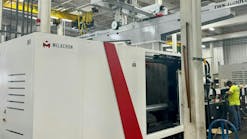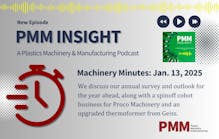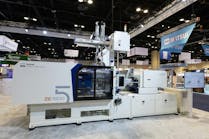Does it sound contradictory that suppliers of surface treatment technology say a technology is spreading steadily into new markets and applications, yet many manufacturing engineers don't think of it at all? Suppliers say that's the case. Though it can be an advantage when nothing sticks to a plastic product, it's a big problem when something should.
Surface treatment, broadly defined, is the modification of a surface to achieve good adhesion between it and something applied or bonded to it. It is useful for plastics because they generally have inherently low surface energy. Adhesives, coatings, ink, labels and paint can't find enough to hang onto. Treatment increases the surface's energy and wettability, enabling it to form a strong bond with what is being applied.
Why then do many engineers facing an adhesion problem — for example, fully dry ink is wiping right off — not look into surface treatment? Treatment system suppliers say engineers usually look first at what's close: polymer materials, additives, printing technology, process parameters and, of course, the ink. Suppliers also say that, as awareness and understanding of surface treatment spread, processors are turning to it sooner.
Let's look at surface treatment technology itself. It's interesting and worth knowing.
Surface treatment: two theories, multiple methods
Greg Wood, president of surface treatment technology supplier Lectro Engineering Co. Inc., St. Louis, says efforts to improve surface treatment for plastics have been ongoing since the early days of plastics. Much research has been done, yet the understanding of how surface treatment improves adhesion was limited because treatment processes might affect only the upper few hundred angstroms of a plastic surface. Being only one-hundred-millionth of a centimeter long, angstroms are mainly used to express wavelengths and interatomic distances. A few hundred are very nearly nothing, and not much to work with.
Relatively recent technology finally enabled analysis at the nano level and two theories now explain why surface treatment works. The functional group theory says treatment causes surface reactions such as oxidation, the scission of polymer chains and cross-linking, which create functional groups including carbonyl, carboxyl, hydroperoxide and hydroxyl that enhance chemical bonding to the plastic surface. The mechanical-physical theory suggests a molecular-level pitting and cracking of the surface, which allow a mechanical bonding between the plastics surface and what is applied. The two theories don't apply to all treatment approaches, but might both be at play with plasma.
See sidebar on plasma technology here.
Chemical and mechanical surface treatment may seem fairly low-tech, but they are still in use. Chemical treatment, mostly with chlorinated solvents or strong acids or bases, attacks the surface, breaking bonds and creating free radicals that roughen the surface. Wiping a chlorinated solution on a plastic surface before bonding or painting is still widely used in the process of painting plastic auto parts, but is giving way to other treatment methods as safety and environmental rules grow more stringent. Mechanical abrasion of a plastic surface can help adhesion and is most often done with another surface treatment to improve adhesion. The potential drawbacks of chemical treatment and mechanical abrasion should be obvious.
Flame treatment is probably the most familiar surface treatment, using an oxidizing flame of 2,000 degrees Fahrenheit to 5,000 degrees Fahrenheit contacts the plastic surface. Generally, the hotter the flame, the faster and more effective the treatment. Balancing that is the need to minimize the flame's exposure to the plastic to avoid distortion, warping and dulling of gloss finishes. In its favor, flame will vaporize some contaminants and is fast. However, it generally doesn't work on irregularly shaped parts, and it presents obvious safety issues in a manufacturing plant. The treatment requires a relatively high amount of energy.
Combustion's high temperatures create plasma; however, in industrial uses, plasma is applied through lower-heat techniques that rely on the ionization of gases. Unlike other treatments, plasma performs three services at once: It activates the surface by selective oxidation to ensure stronger adhesion of paint, ink, labels, coatings or virtually anything else; it eliminates static charge; and it performs micro-cleaning.
Corona treatment, which has been long used for film and other flat plastic substrates, directs a high-frequency corona discharge through a small air gap at the surface to be treated. On the upside, corona treatment eliminates shrinking and warping and is safer than an open flame. One drawback is that the discharge-emitting electrode has to be close to the part. Multiple electrodes are needed for different parts and more setup time is needed.
Gas plasma treatment is done within a low-pressure chamber. Plasma is formed from a gas such as helium, argon, oxygen or nitrogen, using radio or microwave frequencies. It increases surface energy greatly, works with irregularly shaped parts and allows creation of specific functional groups on the plastic surface. Because it is a batch method and has high equipment costs, gas plasma treatment is mostly used with high-value products such as those in the medical sector.
Open-atmosphere plasma treatment, also known as open-air, atmospheric-pressure and suppressed-spark plasma, generates plasma from the atmosphere under normal air pressure and allows it to be sustained to provide surface treatment of polymers and other substrates. The surface energy levels are higher than with corona systems and the treatment has a longer lifetime. The rate of electron bombardment can be up to 100 times greater, which increases etching on the plastic surface and creates stronger bonding. It can provide 360-degree treatment of 3-D objects with no need for fixtures to support them. No vacuum chamber is needed and it does not use high frequencies or need close proximity to an electrode.
Significantly, since only air and electrical power are needed for plasma surface treatment, and it creates no effluent or volatile organic compounds, it can be integrated easily into existing production processes via conveyors, robotics and other methods. In addition to cleaning, activating and eliminating static on plastic products, atmospheric plasma also works on aluminum and other metals, glass, recycled materials and composites.
Rob Neilley, senior correspondent
Contact:
Enercon Industries Corp., 262-255-6070, www.enerconind.com
Lectro Engineering Co. Inc., 314-567-3100, www.lectroengineering.com
Plasmatreat North America Inc., 847-783-0622, www.plasmatreat.com





